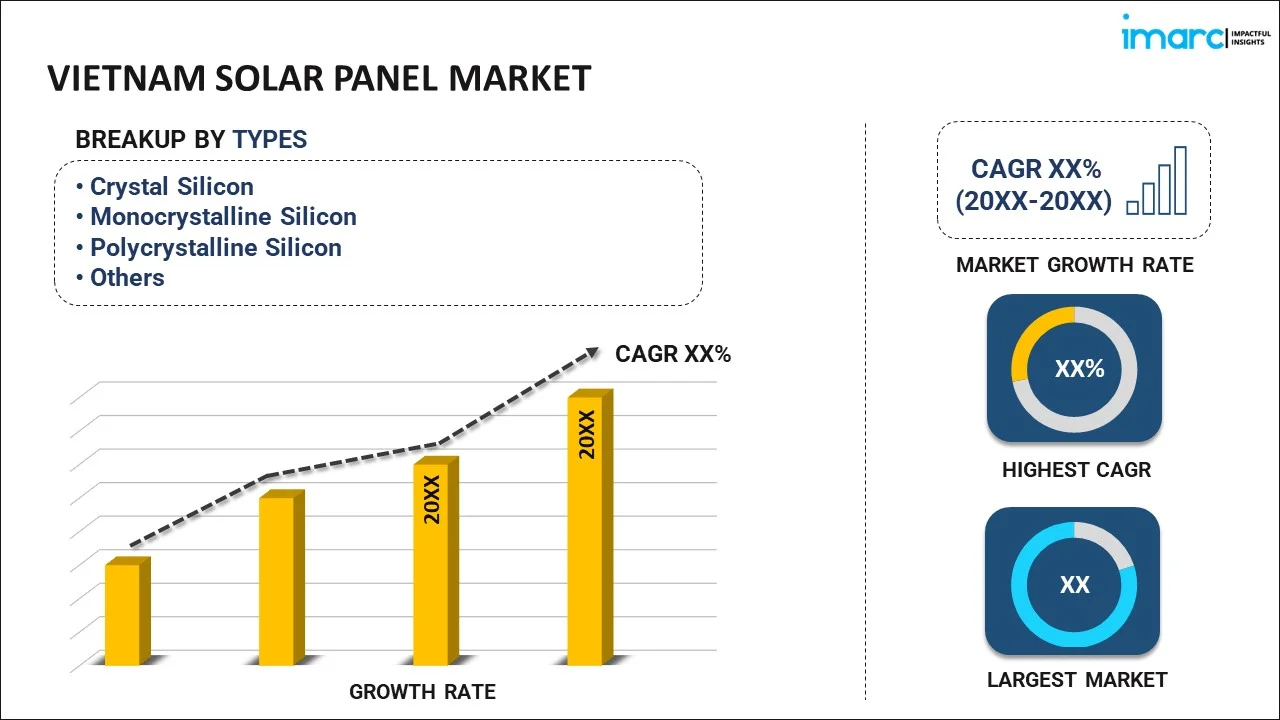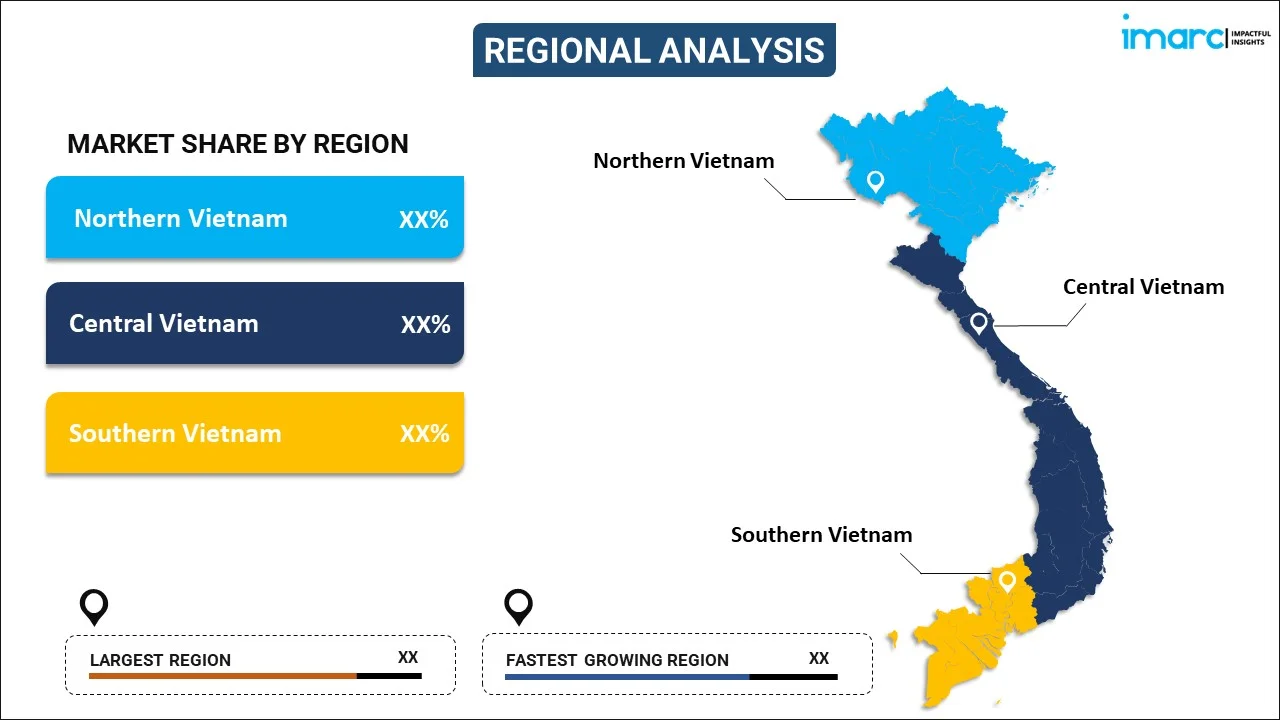
Vietnam Solar Panel Market Report by Type (Crystal Silicon, Monocrystalline Silicon, Polycrystalline Silicon, Thin Film, and Others), End Use (Commercial, Residential, Industrial), and Region 2026-2034
Vietnam Solar Panel Market Overview:
The Vietnam solar panel market size reached 1.3 Gigawatt in 2025. Looking forward, IMARC Group expects the market to reach 2.5 Gigawatt by 2034, exhibiting a growth rate (CAGR) of 7.48% during 2026-2034. The rapid industrial growth and the expansion of the manufacturing sector, the implementation of several government initiatives and policies, the national commitment to achieve Net Zero emissions by 2050, and rapid technological advancements represent some of the key factors driving the market. In 2023, renewable sources accounted for 13.6% of Vietnam’s overall electricity supply, including imports, reaching 37.9 Million kilowatt-hours (kWh).
|
Report Attribute
|
Key Statistics
|
|---|---|
|
Base Year
|
2025 |
|
Forecast Years
|
2026-2034
|
|
Historical Years
|
2020-2025
|
| Market Size in 2025 | 1.3 Gigawatt |
| Market Forecast in 2034 | 2.5 Gigawatt |
| Market Growth Rate (2026-2034) | 7.48% |
Access the full market insights report Request Sample
Solar panels refer to devices designed to convert sunlight directly into electricity. They consist of an assembly of photovoltaic (PV) cells made of silicon, cadmium telluride, copper indium gallium selenide, and other advanced materials for higher efficiency or flexibility. Solar panels are available in various types, including monocrystalline, polycrystalline, and thin-film, each differing in the manufacturing process, appearance, efficiency, and cost. They are characterized by their durability, resistance to environmental factors, and ability to provide clean, renewable energy. Solar panels are widely utilized in residential power generation, commercial and industrial energy supply, agricultural operations, public infrastructure, space exploration, telecommunications, portable power solutions, water heating, transportation, and disaster relief. They aid in reducing carbon footprints, lowering energy bills, promoting energy independence, providing a reliable power supply in remote locations, and supporting sustainable development. Moreover, solar panels are known for their modular nature, allowing for scalability, minimal noise during operation, low maintenance requirements, and potential for integration into buildings and vehicles.
Vietnam Solar Panel Market Trends:
Policy Support and Government Backing
The Vietnam solar market keeps gaining ground owing to steady policy support that lowers project risk and speeds up approvals. Incentives include tax breaks, easier land access, and clearer grid-connection procedures, which help independent power producers secure financing. Regulators are steering new capacity toward transparent, auction-driven pricing and encouraging corporate power purchase agreements to unlock private demand. Provinces with strong irradiance are prioritizing substations and lines to cut curtailment. Local banks are getting more comfortable with solar cash flows, and international lenders are active where contracts are bankable. This mix keeps solar panel Vietnam investment attractive for utility-scale parks and commercial rooftops, drawing EPCs, developers, and manufacturers that want long-term certainty and predictable ramp-up paths.
Rising Focus on Green Energy Goals
Public pressure to cut emissions and improve air quality is pushing the adoption of solar panels Vietnam across factories, malls, and homes. Large exporters want cleaner electricity to meet buyer requirements and ESG reporting, so rooftop systems are spreading in industrial parks. Households are pairing rooftop arrays with smarter meters to trim bills and hedge price spikes. Cities promote solar on public buildings, and lenders now offer consumer loans tailored to small systems. Community outreach on safety and recycling addresses concerns around end-of-life modules. This shift normalizes solar panels in Vietnam, turning them from a niche purchase into a practical upgrade that supports energy security, lowers operating costs, and helps companies show measurable progress on sustainability targets.
Innovation and Efficiency in Solar Technology
New cell architectures and smarter controls are lifting output and cutting levelized costs across the solar energy market. Bifacial modules paired with single-axis trackers squeeze more energy from the same footprint, while higher-efficiency TOPCon and HJT panels improve yields in hot, humid sites. Inverters with granular MPPT handle shading on complex rooftops, and DC-coupled storage is gaining ground to capture midday surplus and shift it to evening peaks. Floating PV on reservoirs reduces evaporation and sidesteps land constraints, with O&M supported by drones and thermal scans. Local assembly of modules, mounting structures, and cables shortens lead times, and better forecasting tools help operators plan around weather and grid limits to keep performance stable year-round.
Vietnam Solar Panel Market Segmentation:
IMARC Group provides an analysis of the key trends in each segment of the market, along with forecasts at the country level for 2026-2034. Our report has categorized the market based on type and end use.
Type Insights:

To get detailed segment analysis of this market Request Sample
- Crystal Silicon
- Monocrystalline Silicon
- Polycrystalline Silicon
- Thin Film
- Others
The report has provided a detailed breakup and analysis of the market based on the type. This includes crystal silicon, monocrystalline silicon, polycrystalline silicon, thin film, and others.
End Use Insights:
- Commercial
- Residential
- Industrial
A detailed breakup and analysis of the market based on the end use have also been provided in the report. This includes commercial, residential, and industrial.
Regional Insights:

To get detailed regional analysis of this market Request Sample
- Northern Vietnam
- Central Vietnam
- Southern Vietnam
The report has also provided a comprehensive analysis of all the major regional markets, which include Northern Vietnam, Central Vietnam, and Southern Vietnam.
Solar Panel Manufacturers in Vietnam:
The market research report has also provided a comprehensive analysis of the competitive landscape in the market. Competitive analysis such as market structure, key player positioning, top winning strategies, competitive dashboard, and company evaluation quadrant has been covered in the report. Also, detailed profiles of all major companies have been provided. Some of the key players include:
- CRC Solar Cell Joint Stock Company
- Green Wing Solar Technology Co. Ltd.
- JinkoSolar Holdings Company
- SolarBK Group
(Please note that this is only a partial list of the key players, and the complete list is provided in the report.)
Vietnam Solar Panel Market News:
- In July 2025, Solar & Storage Live Vietnam 2025, hosted on July 9–10 at HCM City’s SKY Expo, drew over 5,500 attendees, 250+ exhibitors, and 120+ expert speakers. The event spotlighted solar and energy storage solutions, from rooftop PV and BESS to DPPA frameworks and smart grid integration, with strong support from local partners like AHK and GIZ. It reinforced Vietnam’s growing market maturity and accelerated dialogue around scalable solar deployment.
- In November 2024, Meliá Hotels expanded solar adoption in Vietnam with installations at Meliá Vinpearl Cua Hoi Beach Resort and Meliá Vinpearl Cua Sot Beach Resort. Over 2,000 panels were deployed across rooftops, parking areas, and service spaces, boosting renewable use in hospitality. These projects highlight growing demand for solar panels in Vietnam’s commercial sector, supporting the nation’s shift toward clean energy and reinforcing solar’s role in reducing reliance on conventional power sources.
Vietnam Solar Panel Market Report Coverage:
| Report Features | Details |
|---|---|
| Base Year of the Analysis | 2025 |
| Historical Period | 2020-2025 |
| Forecast Period | 2026-2034 |
| Units | Gigawatt |
| Scope of the Report | Exploration of Historical Trends and Market Outlook, Industry Catalysts and Challenges, Segment-Wise Historical and Future Market Assessment:
|
| Types Covered | Crystal Silicon, Monocrystalline Silicon, Polycrystalline Silicon, Thin Film, Others |
| End Uses Covered | Commercial, Residential, Industrial |
| Regions Covered | Northern Vietnam, Central Vietnam, Southern Vietnam |
| Companies Covered | CRC Solar Cell Joint Stock Company, Green Wing Solar Technology Co. Ltd., JinkoSolar Holdings Company, SolarBK Group |
| Customization Scope | 10% Free Customization |
| Post-Sale Analyst Support | 10-12 Weeks |
| Delivery Format | PDF and Excel through Email (We can also provide the editable version of the report in PPT/Word format on special request) |
Key Benefits for Stakeholders:
- IMARC’s industry report offers a comprehensive quantitative analysis of various market segments, historical and current market trends, market forecasts, and dynamics of the Vietnam solar panel market from 2020-2034.
- The research report provides the latest information on the market drivers, challenges, and opportunities in the Vietnam solar panel market.
- Porter's five forces analysis assist stakeholders in assessing the impact of new entrants, competitive rivalry, supplier power, buyer power, and the threat of substitution. It helps stakeholders to analyze the level of competition within the Vietnam solar panel industry and its attractiveness.
- Competitive landscape allows stakeholders to understand their competitive environment and provides an insight into the current positions of key players in the market.
Key Questions Answered in This Report
The solar panel market in Vietnam reached 1.3 Gigawatt in 2025.
The Vietnam solar panel market is projected to exhibit a CAGR of 7.48% during 2026-2034, reaching 2.5 Gigawatt by 2034.
The Vietnam solar panel market is driven by rising electricity demand, government incentives under the FIT scheme, abundant solar potential, declining installation costs, and foreign investment. Industrial expansion, environmental goals, and supportive regulatory policies also contribute to rapid adoption across residential, commercial, and utility-scale projects.
Need more help?
- Speak to our experienced analysts for insights on the current market scenarios.
- Include additional segments and countries to customize the report as per your requirement.
- Gain an unparalleled competitive advantage in your domain by understanding how to utilize the report and positively impacting your operations and revenue.
- For further assistance, please connect with our analysts.
 Request Customization
Request Customization
 Speak to an Analyst
Speak to an Analyst
 Request Brochure
Request Brochure
 Inquire Before Buying
Inquire Before Buying




.webp)




.webp)












